Conversation 25: The dream and its connections to the array of internalized characters that as we hypothesize constitute our "social self"
Hello to our dear followers
Introduction
Dreams were an important subject in ancient times and were interpreted and understood in different ways by different cultures and civilizations. It was generally believed that the dreamer goes wandering in the world of dreams or that the dream penetrates him in a passive way, and sometimes is sent to him by the gods.
In ancient Egypt, dreams were considered significant, and dream interpretation was an essential part of their religious and cultural beliefs. The Egyptians believed that dreams were a way to communicate with the gods and that they contained messages about the future. In the 14th century BC, appeared the earliest dream book with interpretations of these transmissions. It is interesting to note that the Egyptian dream solvers introduced the "theory of contrasts": they claimed, for example, that a dream of death foretells a long life.
In ancient Greece, dreams were believed to be messages from the gods, and their interpretation was essential to understanding the will of the gods. Many sacred places in Greece were used for the "incubation" of dreams: the visitors were invited to use drugs and potions that put them to sleep, and their dreams were defined as prophecies, in connection with the illnesses and circumstances of the dreamers' lives.
In ancient Rome, dreams were also considered significant and were often used to predict the future. The Roman writer and orator Marcus Tullius Cicero wrote a famous book on the subject called "Interpretation of Scipio's Dream", which explored the meaning of his dream and its interpretation. In this dream, Scipio is exposed to the eternal life of the soul, and as he looks out over the entire universe, he learns its secrets and realizes that our existence in this world is fleeting and meaningless.
In ancient China, dreams were believed to be a way to communicate with the ancestors and spirits, and their interpretation was essential to understanding the will of the gods. The Chinese also developed a system of dream interpretation, which was based on the symbolism of various objects and events in dreams. In general, dreams were seen as significant and were often interpreted as messages from the divine or the supernatural. In Matach's educational library it is noted based on sources that Chinese scholars believed that dreams occur when the spiritual soul is temporarily separated from the body and can converse with the souls of the dead, or with the gods. Thus, in the 14th century AD, visitors to a Chinese city were required to sleep the first night inside the temple of the god of the city, in order to be able to receive the transmissions – which is somewhat reminiscent of the "incubator" temples of classical Greece.
We have to admit that there are many theories about the nature of dreams, which implies that one central theory that is solid and backed by scientific evidence has not yet been formulated.
In general, some of the prominent dream theories claim that the role of dreaming is, among other things: consolidating memories, processing emotions, expressing our deepest desires, gaining practice in dealing with potential dangers, and more. Thus many experts believe that we dream due to a combination of these reasons and not due to one particular theory. In addition, while many researchers believe that dreaming is essential for mental, emotional and physical well-being, some scientists suggest that dreams serve no real purpose at all.
Let's go into more detail about the theories of dreaming:
First there is Sigmund Freud's psychoanalytic theory: this theory suggests that dreams represent a disguised form of repressed and unconscious urges, desires, and emotions. According to this theory, the dreamer's subconscious uses symbolism to express these repressed desires. In a dream according to Freud, prevails primary thinking.
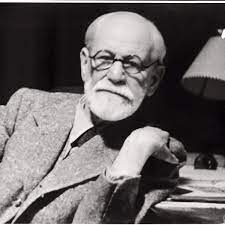
Sigmund Freud, the father of psychoanalysis [1856 – 1939]
On the other hand, there is the activation-synthesis theory: this theory suggests that dreams are the result
of random neural firing in the brain stem that activate certain parts of the brain responsible for creating a story-like narrative. The brain tries to make sense of these random signals by creating a dream story.
The previous head of the sleep unit at Harvard, Dr. Alan Hobson, developed this theory that dreams are the result of random firing of neurons in the brainstem that activate certain parts of the brain responsible for creating a story-like narrative. The brain tries to make sense of these random signals by creating a story. Hobson proposed that the brainstem, the most primitive part of the brain, sends signals to the higher brain centers during sleep, causing the cerebral cortex to be activated. During sleep, however, the higher cognitive functions of the brain are largely turned off, so the signals from the brainstem cannot be interpreted in the usual way. Instead, the brain tries to make sense of these random signals by creating a story-like narrative that we experience as a dream. Hobson proposed that the brain uses the same neural circuits during dreaming as it does during waking awareness, but the sensory input and emotional states normally provided by the external world are absent during sleep, so the brain produces its own sensory and emotional inputs to create the dream experience.
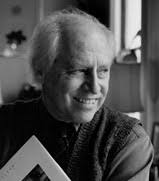
Dr. Alan Hobson [1933- 2021]
Thirdly, the threat simulation theory was proposed: this theory suggests that dreams evolved to help us practice and prepare for threats and challenges in real life. According to this theory, dreams are a type of simulation that allows us to practice our responses to potential dangers and thereby improve our chances of survival.
Fourthly the problem solving theory was proposed: this theory suggests that dreams help us solve problems by facilitating creative thinking and problem solving. Dreams provide a safe space for the mind to explore different possibilities and think of new solutions.
Fifth, the theory of memory consolidation was proposed: this theory suggests that dreams play a crucial role in consolidating and integrating memories. According to this theory, during sleep the brain processes and organizes memories, and dreams reflect this process. The current director of the Sleep and Brain Imaging Laboratory at Harvard Medical School, Dr. Robert Stickgold, has contributed to several theories of dreaming. One of the most prominent of them is the sleep-dependent memory consolidation theory. According to this theory, sleep plays a crucial role in forming and integrating new memories. During sleep, the brain processes and organizes the information acquired during the day and consolidates it into long-term memory. This process is essential for learning and memory retention. Dr. Stickgold has conducted many studies on the role of sleep in memory formation, and his research has shown that certain types of memories are selectively enhanced during sleep. For example, studies have shown that declarative memories (for facts and events) are more likely to be formed during slow wave sleep, while procedural memories (for skills and habits) are more likely to be formed during REM sleep. In addition to the sleep-dependent memory consolidation theory, Dr. Stickgold also proposed the sequential processing theory of dreaming. According to this theory, dreams are a reflection of the brain's attempt to integrate new memories with existing knowledge structures. The brain does this by processing information sequentially and hierarchically, While basing himself on existing concepts and associations, it is interesting that in an interview with him on YouTube, Stickgold suggests that weak associative links between events are created during the sleep between events, which contributes to the creation of new alternatives.
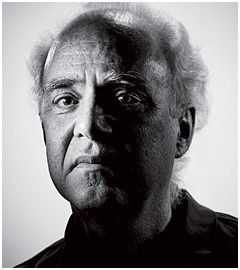
Robert Stickgold [1945 – ]
Sixth, there is an evolutionary theory of dreaming: this theory suggests that dreams are an evolutionary adaptation that helps us survive by giving the brain a way to go back and prepare for real-life situations. This theory suggests that dreams helped our ancestors anticipate and respond to dangers, predators and other environmental challenges.
Seventh is the information processing theory: this theory suggests that dreams help us process and integrate new information and experiences. According to this theory, the brain uses dreams to consolidate and integrate new information into our existing knowledge structures.
Finally, there are a variety of psychotherapeutic theories apart from Freud's: these theories suggest that dreams can provide valuable insights into the emotional and psychological state of the dreamer. Psychotherapists often use dream analysis as a tool to help patients understand and resolve underlying psychological problems and conflicts. In the treatment of the gestalt approach of Franz Perls, for example, it is suggested that everything, even if it is an object, refers to self and represents a part of it.
Carl Jung's approach is particularly interesting. Carl Jung believed that a person has not only a personal subconscious but also a collective one that expresses the cultural heritage. Jung talked about archetypes. The archetype is an "ancient model", a kind of prototype of an idea, person, object or situation that humanity, in its various cultures, has frequently experienced and it is preserved as a deposit in human memory. Jung's theory deals, among other things, with two archetypes, the persona and the shadow. The persona is "us" in essence the persona we wear in everyday life, or "us" as we are known to our friends. The shadow is the "us" that we repress, and this shadow pops up every time we try to fool ourselves into thinking that the persona represents everything that needs to be known about us. Many times, according to Jung, this shadow appears in dreams. Jung thought that one of the purposes of dreams is to give the dreamer a greater sense of balance. Thus, if a dream can express a pole opposite to the one we adopt during the day, then the intention is to push for a balance that can contain parts of the shadow. Jung encouraged his patients to expand on the dream events – "in a kind of guided imagination", and learn from them how to increase balance in life.
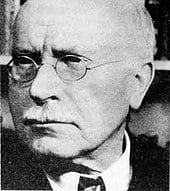
Carl Jung [1875 – 1961]
The question arises as to how the dreams manifest in practice. An example of a detailed dream that was recorded and published is the one experienced by the British writer and journalist Charlotte Beradt. She collected dreams of people who lived under the Nazi regime in Germany and later published them in a book called "The Third Reich of Dreams" (1966).
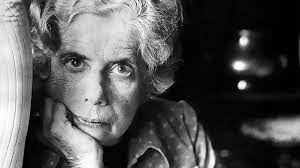
British writer and journalist Charlotte Beradt
One of the dreams recorded in the book is as follows:
"I dreamed that I was at the opera. I'm a big opera fan and it was a performance of Beethoven's Fidelio, which begins with the prisoners' choir. When the curtain went up, I saw the prisoners come out of their cells, like in an opera. Suddenly they stopped singing and started mingling with the audience in the stalls, boxes, bleachers and standing. Everyone was wearing the prisoners' clothes that the Nazis had given them, with the control numbers and colored triangles. The ushers were dumbfounded, not daring to ask for their tickets, and the people in the audience simply moved aside to make room for the prisoners. I was also sitting in the stalls, and a man in a tattered suit and a green identification triangle sat down next to me. He wanted to start a conversation, but I didn't dare to answer. I was too afraid that I too would be taken with them during the break."
A patient we met reports two dreams that he wrote down in a dream notebook as soon as he remembered them.
The first: "I am in an old Nouveau Art style apartment building. It is a stone building with Italian stairs. The house itself belongs to the Nazis and a senior Nazi lives and works inside it. I am Jewish, and there are maids going up and down the stairs. On the first floor opposite the stairs there is a corridor to the Nazis' offices and there are summoned citizens waiting. Everyone is bareheaded. I think in the dream is it possible for someone to eliminate this Nazi. In the meantime, an explosion occurred in a nearby building standing on a road junction, its front is rounded and from the second or third floor appears an unharmed Hitler and next to him are two officers who were wounded in their hands and head by the explosion."
The second: "I go out into the street in Jerusalem and want to travel along Ben Yehuda Street. I get on line 12. My feet stop on the steps at the entrance to the bus. I sit there on the steps and can't stand and get in. The driver waits patiently. In the end, somehow with the help of my hands I stand and sit in the first seat next to a man who turns out to be a doctor, a heart surgeon. He hands me out a sheet about a patient who is about to undergo a heart transplant. And here the thin, young patient destined for a transplant walks through with his elderly mother, followed by a young, handsome, relaxed guy from whom the heart will be taken for transplantation. At a certain moment, the doctor from the bus enters through a door that appears at the front of the bus, which turns out to be the door of operating room and asks for the sheet he gave me and says "I shouldn't have given it to you". I get off the bus at the end of the street on the way to the Old City in Jerusalem. By the way, with the doctor was a dwarf who looked like a baby who knew how to act as a qualified nurse, helping with the surgery. Before I get off, the bus itself already looks like a hospital ward and a doctor suggests that they take an x-ray of my lungs to see if I can also donate a heart, because otherwise why am I there? I explain to him that I am not fit to donate and he is not convinced. In all stages of the dream I do not doubt the events and they seem natural to me."
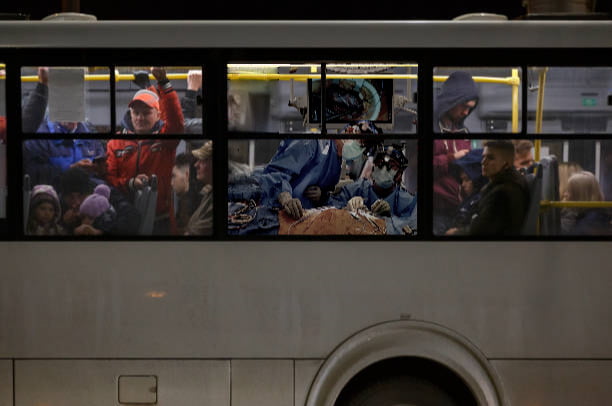
Open heart operation in a bus: a photograph edited with Artificial Interlligence
We can see here the characteristics of dreams and especially the noticeable decrease in the ability to judge and control as well as the initial thought process used in the dream.
Here we would like to ask what are the expressions of "the self" in a dream?
In psychology, especially in the context of Carl Jung's analytical psychology, the concept of "self" refers to the union of the conscious and unconscious aspects of the individual. The self is considered the central organizing principle of the soul and represents the individual's aspiration for perfection and self-realization.
In dreams, according to Jung, the self can express itself in different ways, such as:
1. Archetypal symbols: The self may appear in dreams as universal symbols or archetypes that represent the totality of the individual. Common archetypal symbols of the self include the mandala (a circular or symmetrical shape), the ouroboros (a snake biting its tail), or other symbols of wholeness and unity.
2. Anima and animus: According to Jung, the anima represents the feminine aspect of the man's unconscious, while the animus represents the masculine aspect of the woman's unconscious. These figures may appear in dreams as the opposite sex or as a mixture of masculine and feminine traits, representing aspects of the dreamer's personality that must be integrated into his consciousness.
3. A wise old man or woman: the self may manifest as a wise and old figure who imparts guidance or knowledge. This figure represents the wisdom and experience of the unconscious, which can help the dreamer navigate challenges and make important decisions.
4. Mythical and religious figures: The self may appear in dreams as gods, goddesses, or other spiritual beings who have a sense of perfection, transcendence, or divine wisdom. These figures can symbolize the dreamer's journey to self-realization and the integration of the various aspects of his soul.
5. Magical animals or creatures: The self can also be expressed as animals or mythological creatures with unique properties or abilities, which represent aspects of the dreamer's personality or soul that must be recognized or developed.
We will note here that the self in a dream is represented by archetypal figures. It is also important to remember that the fulfillment of the self in dreams is very individualistic and depends on the dreamer's personal experiences, beliefs and cultural background. Interpreting the self in dreams requires an understanding of the unique context of the dreamer and the specific meanings of the symbols to the person.
And we asked ourselves whether it were possible that the "self" changes in dreams?
The idea that the self may change or even split in dreams is not usually associated with a specific researcher or theorist. The idea of a less coherent dream self has been discussed by various psychologists, neuroscientists and dream researchers. They claim that the dream self can differ from the waking self in terms of continuity, stability and coherence.
Some points to consider about the self in dreams:
1. Dream Strangeness and Fragmentation: Dreams can often be strange, disjointed and seemingly illogical, leading to a perception of a fragmented or disintegrating self. This phenomenon is not specifically attributed to a single researcher, but is discussed by many psychologists and dream researchers.
2. Discontinuity of self across dreams: The sense of self in dreams may not remain consistent between different dream episodes, leading to a less coherent impression of self. Characters, settings, and situations can change quickly, which can make it difficult to establish a stable sense of self in dreams.
3. Altered states of consciousness: Dreaming is considered a different state of consciousness, in which the self can be experienced differently than in waking life. The dream self may be more fluid or flexible, allowing for transformations and experiences that were not possible in the waking state.
4. Cognitive neuroscience perspective: From a cognitive neuroscience perspective, splitting or disintegration of the self in dreams may be related to neurobiological processes that occur during sleep. For example, the prefrontal cortex, which is involved in logical thinking and self-awareness, is less active during REM sleep, when most dreaming occurs. This reduced activity may contribute to changing the sense of self experienced in dreams.
And we will continue to ask: if the self is a coalition of internalized figures that are significant to a person, what happens to it in the dream?
We could assume that if the self is understood as a coalition of internalized important figures or influential people in a person's life, the self in dreams may take different forms or manifest in different ways:
1. Representation of important characters: the introverted characters may appear as themselves or as a fusion of several people in dreams. These dream figures can symbolize the dreamer's relationships, feelings or unresolved conflicts with these significant others.
2. Accepting roles and attributes: In dreams, the dreamer may assume the roles or adopt the characteristics of these important characters. It can represent the dreamer's identification or emulation with the influential people in their lives.
3. Emotional Processing and Problem Solving: Dreams may provide a space for the dreamer to process emotions, confront unresolved issues, or explore potential solutions related to their relationships with these significant figures. The self in the dream may engage with these internalized characters, allowing the dreamer to face emotional challenges or gain new perspectives.
4. Integration and personal growth: Dreams can serve as a means of integrating the influences of these important figures into the dreamer's sense of self, and lead to personal growth and development. This integration may involve reconciling conflicting viewpoints, internalizing positive traits, or moving away from negative influences.
5. The fluidity of the dream self: The dream self is often more fluid and flexible than the waking self. As a result, the dreamer may experience different combinations of these internalized characters or even switch between different roles or perspectives, reflecting the complexity and flexibility of the dream self.
In conclusion, if the self is seen as a coalition of important figures that are internalized, it can manifest itself in dreams through various scenarios involving those influential people. Dreams can provide a space for emotional processing, problem solving, and personal growth related to these significant character attitudes and characteristics. The fluid and flexible nature of the self in a dream allows diverse experiences and an investigation of the various influences that shape a person's identity.
And we will continue and ask more. If the self is seen as a coalition of internalized important figures with an internalized leader and censor what happened to this coalition in dreams?
If the self is conceptualized as a coalition of internalized important figures with an internalized leader and censor, dreams may serve as a space to explore and process the dynamics of this coalition. In dreams it is possible to examine, challenge or redefine the relationships and interactions between these internalized characters and the dreamer. Here's what could happen to this dream coalition:
1. Representation of internalized figures and leader:
The significant figures and the internalized leader may appear as dream figures, representing different aspects of the dreamer's personality, beliefs or values. The leader can symbolize authority, guidance or control in the dreamer's life.
2. Challenging the censorship: dreams can offer a space where the dreamer with his collection of internalized figures confronts the censor or bypasses it. In this context, the censor may represent the dreamer's limitations or internalized social norms. Dreams can provide a safe environment for the dreamer to explore taboo subjects, repressed emotions, or unconventional ideas that may be censored in waking life.
3. Investigating power dynamics: The dreamer may experience various scenarios involving power dynamics between the internalized characters, the leader and the censor. These scenarios can provide insight into the dreamer's feelings of control, autonomy, and self-esteem.
4. Re-evaluation and reorganization: Dreams can serve as a space for re-evaluation and reorganization of the coalition of the internalized figures. This may involve the dreamer questioning the influence of certain characters, changing the balance of power within the coalition, or seeking to incorporate new perspectives and experiences.
5. Emotional Processing and Problem Solving: By engaging with the coalition of internalized characters, the leader and the censor in dreams, the dreamer can process emotions, confront unresolved issues, and explore possible solutions related to their sense of self and relationships with these influential people.
In summary, when the self is seen as a coalition of internalized important figures with an internalized leader and censor, dreams can serve as a space for the dreamer to explore and process the dynamics within this coalition. Dreams may provide opportunities to confront censorship, examine power dynamics, reevaluate the roles of internalized characters, and engage in emotional processing and problem solving related to the dreamer's sense of self.
We will now move on to the relationship between the content and essence of the dream and REFERENCE GROUP FOCUSED THERAPY [RGFT]
But before that we will first mention several concepts related to REFERENCE GROUP FOCUSED THERAPY that appeared in the first conversations.
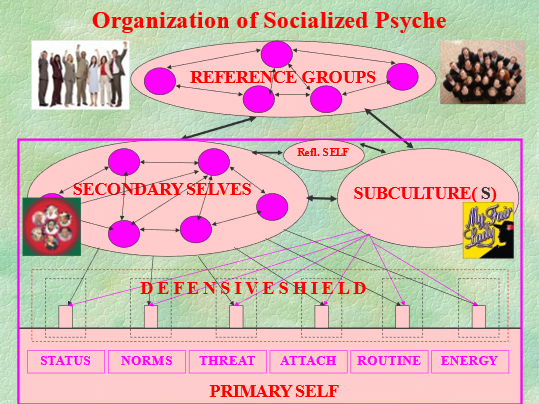
We note that the social self is mainly influenced by the external reference groups [in external reality] and even projects onto them what is reflected in the figure above.
Below are the definitions of the structures and concepts that appear in the model illustrations.
A] It was said first that a structure is defined as a mental structure that expresses a defined function or functions
B] External groups are defined as a group of people in external reality who have some common denominator and mutual interactions
C] Urges are defined here as a mental biological aspect that expresses an urgency to fulfill a survival need, and include the urge to eat, drink, have sex, socialize, avoid risks such as cold and heat that endanger human health, etc.'
D) Sensitivity channels (ISC – INTERNAL SENSITIVITY CHANNELS -) are defined as hypothetical structures included within the RGFT [REFERENCE GROUP FOCUSED THERAPY] concept, individual in nature and in their potential expression, and reflect our personal response to a variety of stressors (both external and internal). Stress and even emotional disbalance can cause them to be activated. Their structure and activity changes along the timeline during life especially during developmental windows but also following aging processes, certain medications, trauma, diseases, etc.
RGFT assumes that these sensitivity channels can be classified into six categories. 1] the channel associated with one's perceived status; 2] the one related to social norms; 3] the one associated with a sense of threat; 4] the one related to the person's sense of attachment; 5 ] the one related to routines and finally, 6] This is related to the level of subjective energy.
For example: a person for whom the issue of status and personal status play a significant role, will express the greatest sensitivity to any threat to his status, while if he is not sensitive to a threat to his routines, such a change will not pose a threat to him.
In the illustration appears the term DEFENSIVE SHEILD or defensive masking, referring to the defensive reactions of the person following the anxiety caused by the channels of sensitivity to one of the perceived threats.
In this model one has first to differentiate between the primary self, which is actually the basic biological core consisting of several innate structures and which is subject to development during life. and the secondary (social) self, which is a structure that develops during a person's exposure to social influence, and consists of internalizations of figures significant to the person, originating either from external groups or from imaginary groups related, for example, to a character from a story, from a myth, from a movie, etc. that had a considerable influence on the person).
The physical self is defined as the set of experiences related to the perception of the body, its limits and sensations, and also includes thoughts, attitudes and feelings towards the body, and which begins with the innate physical self which, as mentioned, continues to develop in human life.
The "secondary selves" include 1] the variety of representations of the "I" that originate from attitudes and feelings towards the self and its representations in different periods of life 2] the representations of internalized characters that often originate from significant characters that the person is exposed to during his life but as mentioned there may also be imaginary characters represented in books, movies, etc. ' that had a considerable influence on man. 3] the representations of the "subculture" [subculture refers to social influences in the milieu [environment] in which the person lives and are not necessarily related to a specific person]
And finally we will mention the "reflective self" which is defined as a structure that develops following the development of the social self and enables a comprehensive view of the individual's state of awareness and mental expressions.
If we try to integrate these assumptions within the framework of RGFT we would have to address the following questions:
1. what role do the Secondary Selves play during a dream, how does their functioning alter in comparison to the wake state?
2. what role does the Dictator Self, as a specific kind of a Secondary Self, play in the “censorship” of the dream content? How does this “censorship” differ from the one during the wake state?
3. what role do the Sensitivity Channels play in formation of the dream content?
4. what role does dreaming play in creating new Secondary Selves and in modification of the established Secondary Selves?
1. Role of the Secondary Selves during the dreaming process.
One of the key assumptions of the RGFT is that our “social self”’ or, in a more generally accepted terms, our self-awareness, is constructed from various Secondary Selves, influential characters, partly real persons or groups and partly imaginary ones that that we faced during our lifespan.
While dreaming, we usually perceive a scenery that greatly differs from our everyday experience. It can contain persons or objects we never encountered in our life in exactly the same form, we can perceive ourselves in an age, position, even gender that does not match our present situation. Still, a dream is usually a “first person” discourse, in this regard similar to our usual “wake” experience.
From the stand point of the RGFT, all the characters that inhibit our brain have to possess some personal significance as the not significant occurrences don’t store in our long-term memory. This is also an opportunity to remind ourselves that Secondary Selves are actually represented in our brain as neuronal nets occupying various positions in the long-term memory. Here we have also to keep in mind that our dream content as far as we know today, reflects both short-term memory traces as well the long-term ones. And, to state it once again, our previously formed Secondary Selves are represented exclusively in the long-term memory.
So, all the characters that we experience and recognize in our dreams as stemming from our past are actually our Secondary Selves.
As Freud already argued, and we have to agree with him, considering the fact that all known mammals dream and that our symbolic language and logical thinking associated with it, are very new in humans’ evolutionary process, the dream content lacks as Freud called it, “secondary thought” and does not take into account logical reasoning. As RGFT emphasizes, one of the important features of a particular Secondary Self are its attitudes. But attitudes are expressed in symbolic language and have to be logically interconnected, so they cannot be utilized or expressed in their full meaningfulness during the dream. This has implications both for each Secondary Self in its own expressing within a dream and for interactions between various Secondary Selves.
Thus, a particular Secondary Self can express statements that may sound contradictory to its essence, may contain features that are contradictory to its usual emotions, appearance, behavior and so on. Various Secondary Selves can interact in an unusual manner, can exchange parts of their appearance, behavior, characteristic emotions, statements, etc.
Another aspect that is important to mention is that Secondary Selves in their aberrant behavior (as compared to the expected in reality) may be more compliant with our conscious or unconscious wishes. These wishes may be even contradictory to the Dictator Self’s attitudes but mostly reflect a persons profile of its Sensitivity Channels.
2. What role does the Dictator Self, as a specific kind of a Secondary Self, play in the “censorship” of the dream content?
As RGFT argues, Dictator Self (or Dictator Selves) serve as kind of a content filter (“censorship”) in creating new Secondary Selves, preferring characters that comply with Secondary Self’s attitudes.
As logical connections are significantly less prominent during the dreaming state, the content during the dream can be less compliant with the Dictator Self’s attitudes. The “censorship” will however return while in a wake state. This mat partially explain the fact why it’s so hard for us to remember dreams and why if we still do remember them we easily miss a lot of their details.
3. What role do the Sensitivity Channels play in formation of the dream content?
The RGFT implies that each individual has its specific set of sensitivities to various external stressors (triggers). RGFT counts 6 of different possible triggers and calls them Sensitivity Channels. They are: Status, Norms, Attachment, Threat, Routine, Energy. They are closely associated with a person’s motivation and may have both adverse and favorable character. In our view, these Sensitivity Channels affect considerably the dream content as they reflect person’s wishes and fears. A dream provides a perfect playground where these wishes and fears can be dealt with. Like in a real play, they do not expose a person to considerable risks and enable to train person’s responses to different scenarios, like in a computer simulation.
4. What role does dreaming play in creating new Secondary Selves and in modification of the established Secondary Selves?
Dreaming is probably a part of the mechanism of creating a new Secondary Self (or in other words – of its internalization) as also an instrument to modify an earlier created Secondary Self. As generally recognized, dreaming reflects a transfer of daily events that are stored within the short term memory (mainly in hippocampus) into the long term memory. As there is a vast amount of information that is collected during the day, only a small pert of it has to be transferred further into the long-term memory. This implies filtering. There are probably different kinds of filtering that are at work here, but one of them (in regard to character’s internalization) is probably the “censorship” applied by the Dictator Self. It influences both the decisions what has to be internalized (significant) and what has to be deleted from the short-term memory. As for earlier internalized Secondary Selves – it decides if some changes in the integral image (gestalt) of the external source of the internalized Secondary Self requires some modification in an existing Secondary Self or even creating of a new Secondary Self altogether. In a special case of an extremely traumatic event, this filtering may not succeed in deleting the event completely’ but the Dictator Self may prevent the most traumatic part to enter consciousness. The consequences may be an uncontrolled and incoherent influence of the suppressed memory on the internally contained order and as a consequence developing of a mental pathology.
That's it for now. See you in the next conversation.
Yours,
Dr. Igor Salganik and Prof. Joseph Levine
 Prof. Joseph Levine, M.D. is an emeritus associate professor in the Division of Psychiatry, Faculty of Health Sciences, Ben Gurion University in Israel. Prof. Levine is a certified psychiatrist with clinical experience in controlled trials of adult psychiatric disorders and in psychotherapy. He was awarded a NRSAD independent investigator grant for the study of Creatine Monohydrate in psychiatric disorders -- mainly Schizophrenia. He resides and treats patients in Tel Aviv and all of central Israel.
Prof. Joseph Levine, M.D. is an emeritus associate professor in the Division of Psychiatry, Faculty of Health Sciences, Ben Gurion University in Israel. Prof. Levine is a certified psychiatrist with clinical experience in controlled trials of adult psychiatric disorders and in psychotherapy. He was awarded a NRSAD independent investigator grant for the study of Creatine Monohydrate in psychiatric disorders -- mainly Schizophrenia. He resides and treats patients in Tel Aviv and all of central Israel.
Leave a comment